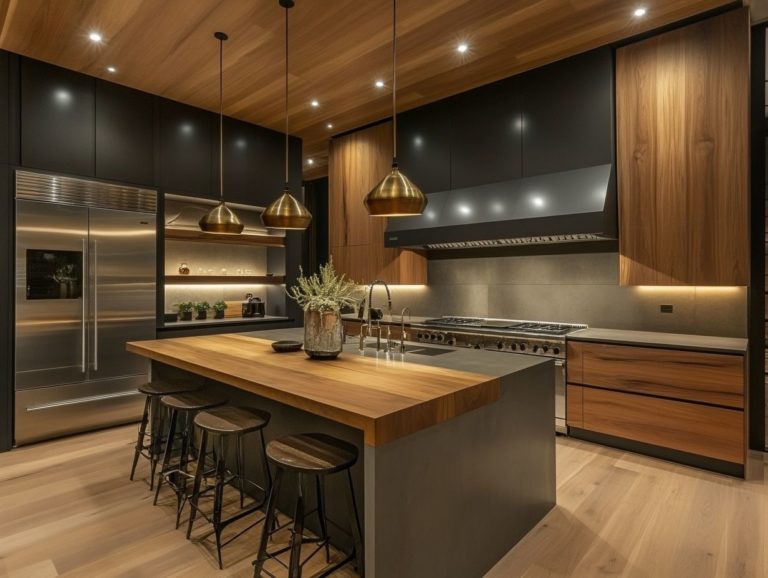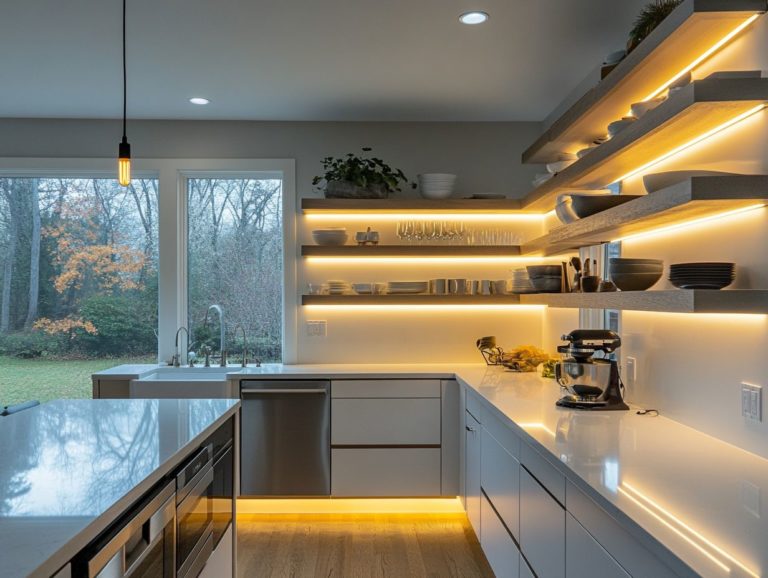5 Unique Ideas for Layering Kitchen Lighting
Transform your kitchen with the right lighting! It enhances both style and functionality.
Explore five unique ideas for layering kitchen lighting. These tips will help create the perfect ambiance for every task.
We will cover key considerations like where to place lights and common mistakes to avoid. Dive into this guide to discover how to illuminate your kitchen beautifully!
Contents
- Key Takeaways:
- 1. Use a Combination of Task and Ambient Lighting
- 2. Incorporate Under-Cabinet Lighting
- 3. Add Accent Lighting
- 4. Utilize Natural Light
- 5. Install Dimmer Switches
- How Does Proper Lighting Affect the Functionality of a Kitchen?
- Frequently Asked Questions
- Looking for Unique Ideas to Layer Your Kitchen Lighting? Here Are Some!
- What Are the Benefits of Layering Kitchen Lighting?
- Which Type of Lighting is Best for Ambient Lighting in the Kitchen?
- What is the Recommended Height for Pendant Lights Above a Kitchen Island?
- How Can I Incorporate a Dimming Feature into My Layered Kitchen Lighting?
- Can I Mix Different Types of Lighting in My Kitchen?
Key Takeaways:

Choose a mix of task and ambient lighting for a bright, functional kitchen.
Incorporate under-cabinet lighting to brighten work surfaces and add depth.
Use accent lighting to highlight design elements and create a warm atmosphere.
1. Use a Combination of Task and Ambient Lighting
Creating a bright kitchen starts with layering lights. Task lighting focuses on specific areas, while ambient lighting creates a warm glow around the room.
These two types work well together. For example, under-cabinet lights provide task lighting, and pendant lights create that warm ambiance.
Where you place these lights affects how your kitchen feels. Thoughtfully arranged lighting can make it feel warm and welcoming.
Mix light sources like adjustable floor lamps and recessed lights for the best look.
2. Incorporate Under-Cabinet Lighting
Under-cabinet lighting enhances your kitchen’s look and function. It brightens work surfaces and adds visual appeal.
This lighting comes in forms like LED strips and puck lights, each offering unique advantages.
Imagine sticking LED strips under your cabinets for a seamless glow. Puck lights offer focused lighting for a classic touch.
Place lights near work areas like countertops and sinks for maximum efficiency. Choose warm light colors to match your decor and keep the room inviting.
3. Add Accent Lighting
Accent lighting enhances the look of your room and highlights features like artwork. This creates a layered, dynamic environment.
Choose options like track lighting or gallery lights to transform your space. Track lighting lets you direct light exactly where it’s needed.
Consider light colors that fit your decor; warm tones feel cozy, while cooler shades offer a modern touch. Adding dimmers can refine the atmosphere, making your space inviting and polished.
4. Utilize Natural Light

Natural light can transform your rooms. It creates a warm, inviting atmosphere and improves the overall design.
To achieve this, consider strategic window placement. Make the most of the sun’s path throughout the day. For example, large south-facing windows invite ample sunlight, while smaller transom windows help distribute light more evenly.
Incorporate reflective surfaces, such as mirrors or glossy finishes on your walls and furniture. This amplifies incoming light, resulting in a brighter ambiance. Opt for lighter shades in your decor to enhance this effect, making your space feel airy and spacious.
Don’t overlook the importance of window treatments. Sheer curtains can elegantly filter light while ensuring privacy, striking a perfect balance between aesthetics and practicality.
5. Install Dimmer Switches
Installing dimmer switches is a simple way to supercharge your home lighting! They allow you to craft a flexible lighting strategy for any occasion or mood.
These devices uniquely enhance both task and ambient lighting. Dim the lights to effortlessly create a cozy atmosphere for relaxation or an inviting environment for social gatherings.
There are various types of dimmers available, including:
- Standard rotary
- Slide
- Smart dimmers
All of these can integrate seamlessly into your comprehensive lighting plan. Smart dimmers offer the luxury of remote control, giving you the power to manage your lighting with mobile apps or voice commands. Tailor your home environment to suit any situation!
How Does Proper Lighting Affect the Functionality of a Kitchen?
Proper lighting is critical for your kitchen’s functionality. It influences everything from meal prep to creating a welcoming atmosphere for family gatherings.
Integrate different lighting functions. Task, ambient, and accent lighting enhance usability. Task lighting refers to lighting that helps you see clearly when cooking or reading.
Ambient lighting sets the mood for your kitchen. Accent lighting draws attention to architectural features or decorative elements, adding depth and interest.
Recent trends point to the growing popularity of smart lighting controls, giving you the power to tailor your kitchen’s illumination to suit your activities. This enhances your cooking experience and fosters a cozy atmosphere for entertaining guests.
What Are the Different Types of Kitchen Lighting?
Kitchen lighting is a multifaceted art, encompassing various types to elevate your space. Task lighting is essential for work areas, ambient lighting bathes the room in a warm glow, and accent lighting showcases your kitchen’s unique features.
Each type serves a distinct purpose. Understanding how these types interact is crucial for crafting a functional yet inviting kitchen.
Task lighting, strategically placed above countertops or islands, ensures well-illuminated food preparation areas, promoting safety and precision in your culinary adventures. Ambient lighting provides essential general illumination, eliminating pesky shadowy corners, often achieved with elegant ceiling fixtures or recessed lights.
Accent lighting adds an artistic touch by drawing attention to your favorite artwork, cabinetry, or architectural details, infusing character into the design.
To create a balanced environment, layer these lighting styles. Adjust the intensity and placement of each type to cultivate a versatile kitchen that adapts to your various activities and moods.
What Are the Benefits of Layering Kitchen Lighting?

Layering kitchen lighting offers many benefits. It enhances your visual comfort and boosts functionality. You can create a versatile atmosphere that shifts seamlessly to accommodate various activities and occasions.
By thoughtfully combining different lighting sources—such as ambient, task, and accent lighting—you can transform your kitchen into a space that is visually captivating and highly efficient.
For example, imagine pendant lights elegantly hanging over your island, providing essential task lighting for your culinary endeavors. Soft LED strip lights under your cabinets enhance visibility during food prep.
Adjustable recessed lights can also be your secret weapon. They highlight artwork or decorative elements while adding a personal touch to your space.
This meticulous layering results in a dynamic environment that effortlessly transitions from casual family gatherings to sophisticated dinner parties. Ensure your kitchen is both a practical workspace and a warm social hub.
How Can One Determine the Best Lighting Placement for Their Kitchen?
To find the best lighting placement, consider your kitchen’s functional areas. Ensure task lighting effectively illuminates your workspaces while ambient and accent lighting enhances the overall ambiance.
Start by assessing your kitchen and identifying the primary work zones, such as the cooking area, prep space, and sink. Each zone deserves its tailored lighting solution.
For instance, installing bright LED task lights above your countertop can dramatically improve visibility during food preparation. Ambient lighting, such as recessed fixtures or elegant pendant lights, can cast a warm glow that beautifully complements your overall design.
Consider adding dimmers to give you greater control over brightness levels. This allows you to adjust the lighting based on the time of day or your activities.
Mix different fixture styles to enhance your kitchen’s look. Use under-cabinet lights for specific tasks and decorative fixtures for aesthetic appeal.
What Are Some Common Mistakes to Avoid When Layering Kitchen Lighting?
Common mistakes in layering kitchen lighting can impede both functionality and aesthetics. Insufficient task lighting, improper fixture selection, and a lack of consideration for your overall lighting goals can all undermine your space.
These pitfalls detract from the kitchen’s effectiveness and can lead to frustration during meal prep and social gatherings. To address insufficient task lighting, pinpoint areas where precise illumination is crucial, such as over countertops and cooking surfaces.
Selecting the wrong fixtures can disrupt the overall ambiance. It’s wise to opt for versatile options, such as adjustable pendants or recessed lighting, that balance utility with design.
By clearly defining your lighting objectives, you can ensure that ambient, task, and accent lighting work together seamlessly. This transforms your kitchen into a beautifully functional hub of activity.
Frequently Asked Questions
Looking for Unique Ideas to Layer Your Kitchen Lighting? Here Are Some!

- Install lights that are installed in the ceiling so they don’t hang down. This adds a modern touch and provides overall ambient lighting.
- Use under-cabinet lighting for functionality. It adds depth and dimension to your kitchen, perfect for illuminating countertops and workspaces.
- Incorporate pendant lights for specific areas, such as above the kitchen island or sink. They also serve as decorative elements.
- Consider track lighting that can be adjusted to highlight different areas in the kitchen. It creates a dramatic effect or provides focused lighting for specific tasks.
- Utilize natural light. Install large windows or skylights to allow natural light to flood in during the day.
Start reimagining your kitchen lighting today for a brighter, more inviting space!
What Are the Benefits of Layering Kitchen Lighting?
Layered lighting enhances how well your kitchen works. You can pick the right lights for different tasks.
It also creates a warm and inviting atmosphere. This makes cooking and entertaining much more enjoyable.
Multiple light sources improve safety by reducing shadows. This makes it easier to see while you cook.
Layered lighting adds depth to your kitchen. It makes the space look more visually appealing.
Using natural light and various artificial lights can save energy. You’ll likely notice a decrease in your utility bills.
Which Type of Lighting is Best for Ambient Lighting in the Kitchen?
Recessed lighting is ideal for ambient kitchen lighting. It offers overall illumination that you can easily adjust.
What is the Recommended Height for Pendant Lights Above a Kitchen Island?
Pendant lights should hang 30 to 36 inches above the countertop. This may vary based on your island’s height and personal preference.
How Can I Incorporate a Dimming Feature into My Layered Kitchen Lighting?
You can use dimmable bulbs or install a dimmer switch. This lets you adjust the brightness to match your mood.
Can I Mix Different Types of Lighting in My Kitchen?
Yes! Mixing recessed, pendant, and under-cabinet lights creates a balanced, layered effect. Just choose fixtures that complement each other and serve different functions.





